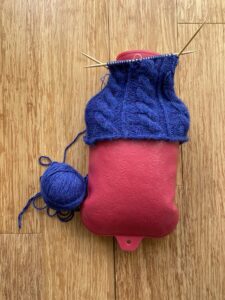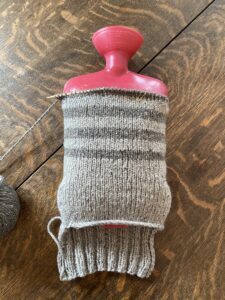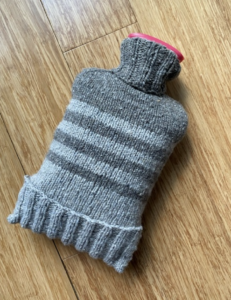I fell in love with my hot water bottle when I was in college. And I’m not your granny’s age — I’m talking about last year.
I had moved into an old house with my sister and two other roommates. The place was furnished, and my room came with a four-poster queen-size bed. Compared to living in a closet-like dorm room, this place felt too good to be true. It was: when the Ohio winter settled in, the ancient radiator in my bedroom groaned and clanked loudly but emitted absolutely no heat. I complained to the landlord. He fiddled with it, gave it a friendly slap with a pair of pliers, and said, “It’ll kick in soon.” It never did. Every night of that winter I huddled in my giant bed shivering and scrunching my toes every few minutes to be sure they were still there.
I must have complained loudly enough to be heard at the North Pole, because at Christmas, when I unwrapped a lumpy gift from Santa Claus, there lay my savior. The rubber bottle with a plug at the top was vaguely familiar to me from storybooks and movies, but I’d never put one to use before. That, it turns out, requires no finesse: Pour hot (but not actively boiling) water in, secure the plug, and pop it under the covers. Your bed becomes an oven, and you’re the lucky bread.
Hot water bottles have probably been around since humans first settled into beds. In antiquity they were made of metal or clay and filled with hot coals, but after rubber became an option in the 19th century, the bottles got more snuggly. And 100 years later, they’re still popular. Chantel Tattoli wrote about them in the New York Times Magazine in 2017: “There must be quite a few things they won’t cure,” she wrote, “but I don’t know many of them.”
Tattoli pointed readers to a classy model, the German-made Sänger, which can be ordered online for about $30. “It looks like a period piece and, in a sense, it is,” she wrote. Not for her the bottles sold in drugstores in the United States, which are “mostly cheap plastic bladders, which stick to your skin like a leatherette car seat.”
But I would propose that the bottle’s material doesn’t matter as long as what’s covering it is comfy. My humble Samply, made of PVC ($9.99), shows no signs of wear after two years of heavy use. What it’s wearing, on the other hand, might need an update, I realized, on researching hot water bottles and finding that fluffy, fuzzy, shaggy, you name it, their covers are now a thing.
I turned to Susan Abbott, who lives in Eastham and is the Independent’s knitting coach (as well as master of design and layout of these very pages). She has never owned a hot water bottle, she told me, but agreed that a miniature sweater for one could be a fun D.I.Y. project.
She picked one up at CVS — “I’m trying to avoid ordering from Amazon,” she said. Then, for help with the patterns, she visited the website Ravelry, which is popular among fiber artists. It has a robust search engine, Abbott said. Which means you can input details like the object you’re trying to make, whether you’re knitting or crocheting, the difficulty level, or the length of yarn you want to use. Most of the patterns on the site are free.

Before choosing a pattern, Abbott said, measure your hot water bottle; they come in different sizes. Any pattern is easily adaptable, she said, by increasing or decreasing the number of stiches or changing the size of your knitting needles. As with a homemade sweater, she said, “Don’t forget to try the cover on as you go.”
She chose two different patterns for the project. For “something with a little bit of interest,” Abbott settled on a round-knit body with a pattern of vertical cabled twists and a high neck that would fit snugly around the neck of the bottle. For this one, Abbott picked out a vibrant indigo wool yarn from her stash.
To begin, she did a “gauge swatch.” Every pattern has a gauge, she told me — it will tell the knitter the target of stitches to an inch: “You’re supposed to do a gauge swatch to make sure you don’t need bigger needles or smaller yarn, otherwise the pattern won’t turn out right.”

Abbott measured her gauge swatch, and it looked right. But halfway through knitting, when she began adding the pattern’s thick vertical cables, she tried the cover on the bottle, and it didn’t fit. The cables had tightened the fit.
“The nice thing about knitting,” Abbott said, “is you can always unravel it and start over.” She put aside her size-5 knitting needles, which were producing four inches of fabric with 20 stitches (five stitches per inch), and went with needles two sizes larger. Size-7 needles made a bigger stitch, which would result in a roomier cover.
Setting that project aside, Abbott started an easier version, choosing a gray yarn in a wool, polyester, and rayon blend (which is more washable than pure wool) and pairing it with a pattern featuring a bottom flap to make it easy to remove the bottle and wash the cover. You could add a button to close the flap, but Abbott sewed the sides of the flap to the sides of the cover, leaving an open slot, like an envelope.

You can get as fancy as you want, Abbott said. But she noted that beginning knitters can make this project even easier by ditching the fit problem altogether. “You could make two rectangles and sew them together,” she said. She has seen some like that with a drawstring at the top.
Even if you’re going very simple, the yarn itself adds its own part to the design. “Do you like something that’s really squishy and big?” asked Abbott. Or the opposite?
Choose a time and place to get the work done. “I usually knit at night,” Abbott said. It’s an excuse to sit and watch TV. And cozy, too: once she’s settled in, “then the cats will come and sit on me.”
Though the indigo cover, still in construction, is beautiful, Abbott said she’s thinking of keeping the gray cover for herself. What’s best about it, she added, will come in handy once Princess, the tuxedo-colored kitty who has draped herself across her lap wanders away: “It’s done.”



